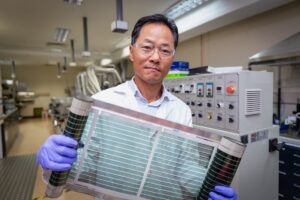For the first time, the conversion efficiency of four-terminal perovskite/silicon tandem devices with certified top cell has passed 30 per cent.
Dutch researchers from the Eindhoven University of Technology (TU/e), working in partnership with Soliance Solar Research, worked together to push the conversion efficiency of tandem solar cells beyond the limit of today’s commercially available solar PV modules.
The researchers hope their breakthrough will enable more power per square metre and less cost per kWh. Further, integrating these solar cells into construction and building elements should become more commonplace, allowing existing surface areas to be covered with solar PV modules.
As the TU/e explain, tandem solar cells are able to reach higher efficiencies than single junction solar cells through a better utilisation of the solar spectrum.
Tandem and four-terminal tandem PV modules
Current tandem solar cell technology combines commercial silicon technology for the bottom device with perovskite technology. Specifically, the perovskite technology features highly efficient conversion of ultraviolet and visible light, as well as excellent transparency to near infrared light.
The top and bottom cells of a four-terminal (4T) tandem solar cells, meanwhile, are able to operate independently of each other, making it possible to apply different bottom cells. This means that commercial PERC technology as well as more premium technologies like heterojunction or TOPCon, or thin-film technology such as CIGS, can all be implemented in a 4T tandem device with hardly any modifications to the solar cells.
Researchers from the Netherlands and Belgium have successfully improved the efficiency of the semi-transparent perovskite cells up to 19.7% with an area of 3×3 mm2. This result has been independently certified by the European Solar Test Installation (ESTI) lab in Italy.
Similarly, the silicon device optically stacked under the perovskite contributes efficiency of 10.4% to the total solar energy conversion. Combined, the conversion efficiency of the researchers’ non-area matched 4T tandem devices reached 30.1%.
“This type of solar cell features a highly transparent back contact that allows over 93% of the near infrared light to reach the bottom device,” said Dr Mehrdad Najafi, of TNO (the Netherlands Organisation for Applied Scientific Research), one of the research partners in Solliance Solar Research.
“This performance was achieved by optimizing all layers of the semi-transparent perovskite solar cells using advanced optical and electrical simulations as a guide for the experimental work in the lab.”
“The silicon device is a 20×20-mm2 wide, heterojunction solar cell featuring optimized surface passivation, transparent conductive oxides and Cu-plated front contacts for state-of-the-art carrier extraction,” added Yifeng Zhao, PhD student at TU Delft, another Solliance member.
Future potential of four-terminal tandem PV modules
According to the researchers, however, this application of four terminal tandem solar PV modules is only the beginning. Combining the highly transparent perovskite cell with other silicon-based technologies – such as back contact (metal wrap through and interdigitated back contact cells) and TOPCon solar cells – has already delivered conversion efficiencies approaching 30%.
The researchers believe that these results demonstrate the potential of highly transparent perovskite solar cells, as well as their flexibility to be paired with existing commercialised technologies.
“Now we know the ingredients and are able to control the layers that are needed to reach over 30% efficiency,” said Professor Gianluca Coletti, program manager of tandem PV technology and application at TNO.
“Once combined with the scalability expertise and knowledge gathered in the past years to bring material and processes to large area, we can focus with our industrial partners to bring this technology with efficiencies beyond 30% into mass production.”










